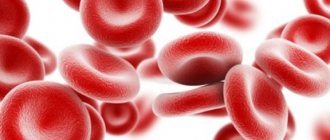Blood is a special tissue of the body that performs numerous physiological functions. Its liquid state allows for the simultaneous activity of its various components (erythrocytes, leukocytes, platelets and others), each of which has its own specific tasks. Erythrocytes (red blood cells) are the most numerous components of blood. Their number is incredibly large - red blood cells make up almost 25% of all cells in the body. However, there are certain physiological norms for the content of red blood cells in the blood.
If the red blood cells in the blood are elevated, then this is a signal of the appearance of “problems” in the body, often very serious ones.
Red blood cells are normal
Red blood cells are actually yellowish in color - and they turn red because they are filled with hemoglobin, which delivers oxygen molecules to all tissues of the body.
The number of red blood cells in the blood of a healthy person varies throughout life and depends on both age and gender (Table of red blood cell norms).
| Age | Indicators |
| Red blood cell norm for adults (over 19 years old) | |
| Men: | 4.2 - 5.3 x 1012/l |
| Women: | 3.5 - 5.2 x 1012/l |
| Red blood cell norms for adolescents (13-19 years old) | |
| Boys: | 3.9 - 5.6 x 1012/l |
| Girls: | 3.5 - 5 x 1012/l |
| Red blood cell norms for children (up to 12 years old) | |
| 3-12 years | 4 - 4.5 x 1012/l |
| 1-2 years | 3.7 - 4.4 x 1012/l |
| 7-11 months | 3.1 - 4.6 x 1012/l |
| 2-6 months | 2.7 - 4.9 x 1012/l |
| 1 month | 3.0 - 5.4 x 1012/l |
| 2 weeks | 3.6 - 6.2 x 1012/l |
| Newborns | 4.0 - 6.6 x 1012/l |
| Cord blood | 3.9 - 5.5 x 1012/l |
The lifespan of red blood cells is 90 to 120 days, after which they are replaced by young red blood cells and old red blood cells are taken up by macrophages. Every second, more than 2 million new red blood cells are formed in the body - and the same number die.
In addition to transporting oxygen, red blood cells also perform some other functions:
- reverse transport of carbon dioxide from tissues to the lungs
- transport of nutrients and bioactive elements
- regulation of cellular acid-base balance
MCV below normal
Tests showing that the volume of red blood cells is below normal also indicates pathology. Experts name a number of reasons that can lead to such results:
- genetic predisposition;
- insufficient amount of water consumed;
- development of various types of anemia;
- lead intoxication;
- the presence of malignant formations, tumors in the body;
- taking medications that affect test results.
In medical circles, a disease in which the level of red blood cells in the body decreases is commonly called microcytic anemia. The peculiarity of the disease is that red blood cells do not perform their transport function, i.e. they do not deliver oxygen and other useful substances to the body’s cells in the required quantities.
With this pathology, a characteristic clinical picture is observed:
- constant fatigue;
- increased irritability, nervousness;
- decreased concentration and performance;
- absent-mindedness;
- memory impairment.
A decrease in the volume of red blood cells is always observed with various types of blood loss.
Pregnancy and mcv
During pregnancy, due to the body's increased consumption of iron, microcytic anemia can develop. This condition can negatively affect both the health of the unborn child and the well-being of the mother.
Some experts are convinced that mcv indicators are directly related to a person’s psychological state.
Elevated red blood cells in the blood - what does this mean?
Red blood cells are sensitive to various pathological changes caused by various diseases, and therefore a blood test and red blood cell level indicators can provide the doctor with a lot of unique information.
As a result of certain pathological processes, the properties of the red blood cells themselves (shape, size, hemoglobin content) may change, but in addition, the number of red blood cells often changes, both downward and upward from normal.
Slightly increased red blood cells in the blood are observed almost every day in healthy people. A temporary increase in red blood cell count may also occur with:
- severe stress
- increased physical and mental stress
- dehydration
- staying in high altitude conditions
- exposure to toxins in the body
After the action of these factors ceases, the number of red blood cells returns to normal.
However, a persistent increase in red blood cells, called erythrocytosis, may indicate quite serious diseases:
- blood diseases
- disorders of the adrenal cortex
- congenital heart disease
- chronic lung diseases
Elevated red blood cells in the child's blood
Elevated red blood cells in a child’s blood may be due to the characteristics of their body. Normal levels of red blood cells in the blood differ from those in adults. It is noteworthy that, starting from adolescence, the norm indicators for boys differ from those of girls (table of red blood cell content in children), which is associated with the appearance of noticeable differences.
| 1-3 months | girls/boys | 3.5-5.1 x 1012/l |
| 3-6 months | girls/boys | 3.9-5.5 x 1012/l |
| 6-12 months | girls/boys | 4.0-5.3 x 1012/l |
| 1-3 years | girls/boys | 3.8-5.0 x 1012/l |
| 3-12 years | girls/boys | 3.7-5.0 x 1012/l |
| 12-15 years | girls/boys | 3.5-5.0 x 1012/l 4.1-5.5 x 1012/l |
| 15-18 years old | girls/boys | 3.5-5.0 x 1012/l 4.0-5.6 x 1012/l |
Due to the ongoing process of growth, the bodies of children and adolescents are very sensitive to the effects of various unfavorable factors, which can affect the blood picture. For this reason, children should regularly undergo laboratory blood tests and, if necessary, consult not only a pediatrician, but also a pediatric hematologist.
Elevated red blood cell levels in an adult
Red blood cells are blood cells responsible for delivering oxygen molecules to cells and removing the metabolic product, carbon dioxide. The lifespan of a cell is about 3 months. Then the blood elements are destroyed in the liver and excreted from the body, and they are replaced by young cells synthesized in the bone hematopoietic germ. Male and female erythrocyte level standards are slightly different:
- in an adult male, the concentration of erythrocytes will be 3.3-5.5*1012 units/ml;
- for a woman, the normal erythrocyte count is 3-4.7*1012 units/ml.
Higher reference values for representatives of the stronger sex are due to the fact that the male body has large muscle mass, which requires an active supply of oxygen. Androgen hormones, synthesized by the male body, stimulate the production of red blood cells.
The amount of red elements in the blood of an adult is higher than normal and requires medical consultation. The appearance of erythrocytosis indicates possible health problems.
Red blood cells - erythrocytes
What does it mean?
Doctors determine what an increase in red blood cells in the blood of an adult means, taking into account an analysis of the characteristics of life and the possible influence of external factors. A slight increase is due to physiological processes:
- living in high mountain areas;
- intense sports activities.
A moderately increased number of red blood cells in an adult without signs of a general deterioration in health indicates that the body strives to compensate for the resulting oxygen deficiency caused by external factors. False erythrocytosis, when red elements are increased in 1 ml of blood with fluid loss. This happens in diseases accompanied by prolonged fever, diarrhea and vomiting.
But more often, the reasons why the erythrocyte count in an adult is elevated are pathological. They provoke deviations in the composition of the blood:
- respiratory diseases accompanied by the development of respiratory failure (COPD, asthma, tuberculosis);
- heart defects;
- kidney and/or liver disease;
- tumors.
Another common reason why the amount of red elements increases in men and women is smoking.
Due to nicotine, the smoker's body experiences oxygen starvation, and this leads to an increase in the synthesis of red blood cells. Erythrocytosis, caused by pathological factors, is accompanied by weakness, increased fatigue, dizziness and other signs of deterioration of health. When there are a lot of red blood cells in a blood test: doctors determine what this means, taking into account all the data from the patient’s examination. This allows us to identify the cause of erythrocytosis.
How to downgrade?
Having independently examined the form from the laboratory and discovered signs of erythrocytosis, there is no need to panic and search the Internet for how to lower the erythrocyte concentration. When red blood cells are elevated in a blood test in adults: what does this mean, the doctor decides.
Some conditions are considered a natural adaptive reaction to external conditions (living in the mountains, intense training) and do not require correction. When red blood cells are elevated due to fluid loss, it is necessary to replenish the lack of moisture by drinking plenty of fluids. In case of severe dehydration, an infusion of glucose and saline solutions is prescribed.
The selection of medications depends on the disease that caused the increase in erythrocyte count. To reduce viscosity use:
- Bleeding. In a hospital setting, 200-300 ml of red liquid is taken from the vein of an adult patient, and then donor plasma or saline is infused.
- Hirudotherapy. When the erythrocyte count is moderately elevated, leeches can be used to thin the blood.
- Oxygen inhalations. If an increase in the synthesis of blood cells has become a compensatory reaction in response to the development of tissue hypoxia due to smoking or respiratory failure, then oxygen therapy will slow down the production of blood elements. When smoking, it is recommended to quit the bad habit.
There are no special medications to eliminate the pathological increase in erythrocyte levels in adults. Patients are prescribed symptomatic therapy to prevent blood clots and blood thinning.
Red blood cells in the blood are elevated in a child: causes
In addition to chronic respiratory diseases, the causes of erythrocytosis (persistent increase in the number of red blood cells) in children can also be:
- deficiency of iron and some vitamins
- congenital heart defects
- oncological diseases of the blood, including leukemia, which are more common among children than among adults
- long-term antibiotic therapy (for example, for chronic tonsillitis).
For children, erythrocytosis is especially dangerous, as it can cause the rapid development of serious complications - in particular, dysfunction of many organs and tissues and enlargement of organs such as the liver, spleen and kidneys.
Elevated red blood cells in the blood in women: causes
Elevated red blood cells in the blood of women may indicate the same diseases as in men - however, there is one important difference in this regard... In the last 1-2 decades, scientists from different countries have reported an increase in the incidence of both bronchial asthma and other chronic diseases. respiratory diseases among the fair sex. However, both asthma and chronic bronchitis can cause an increase in the number of red blood cells. It is worth mentioning that women who smoke have a higher risk of developing chronic respiratory diseases compared to men.
A large number of red blood cells in a child
High erythrocyte counts in children, in the case of true erythrocytosis, indicate the development of the disease.
But the child’s body reacts more acutely to the influence of external or internal non-pathological factors and a temporary increase in the number of red blood cells is caused by:
- teething;
- lesson in the sports section;
- recent cold infections.
Erythrocytosis often develops in children due to passive smoking.
Memo to parents. Even if it seems that the increase in the red blood cell count is associated with sports training or teething, there is no need to postpone a visit to the pediatrician; a repeat blood test should be performed as soon as possible. This will help identify an incipient disease in a child or exclude the development of pathology.
Increased red blood cells and hemoglobin in the blood
In some cases, elevated red blood cells and hemoglobin in the blood indicate a simultaneous increase in both the level of red blood cells (erythrocytosis) and the level of hemoglobin in them. Often, increased levels of red blood cells and hemoglobin are observed in people suffering from heart and respiratory diseases:
- chronic obstructive bronchitis
- emphysema
- chronic obstructive pulmonary disease,
- pneumonia,
- bronchial asthma,
- tuberculosis
MCV is higher than normal
If the results are above normal, this indicates the development of macrocytic anemia. It can be directly related to diseases such as:
- drug intoxication;
- food poisoning;
- problems with the thyroid gland;
- lack of iodine or iron in the body;
- liver dysfunction;
- oncological process of red bone marrow;
- long-term alcoholism;
- disruption of the pancreas.
An increase in mcv can be caused by:
- long-term use of birth control pills that affect hormonal levels;
- addiction to cigarettes and tobacco products;
- prolonged contact with toxic substances (work in hazardous industries);
- taking medications that increase the level of mcv in the blood.
If left untreated, macrocytic anemia can lead to frequent fainting, poor health, and low hemoglobin levels in the blood. Particularly at risk are:
- people who eat poorly, lead a sedentary lifestyle and ignore exercise;
- patients with chronic liver failure;
- people with a genetic predisposition to the disease;
- men over fifty-five years of age who abuse alcohol.
Experts identify some signs by which one can understand that a person’s red blood cell volume is too high:
- unhealthy pale lips;
- abdominal pain for no particular reason, which appears very often;
- the presence of tachycardia (heartbeat too fast), even when the person is at rest;
- skin with a yellowish tint.
If you notice similar symptoms or detect an increased level of mcv in the blood, you must immediately consult a general practitioner for appropriate treatment.
Increased red blood cells and leukocytes in the blood
Elevated red blood cells and white blood cells in the blood are a reason for a prompt and thorough medical examination by a doctor, since such a change in the blood picture is often characteristic of such serious diseases as:
- acute inflammatory processes
- infectious diseases (not only bacterial and viral, but also fungal)
- purulent processes in the body
- heart disease, including myocardial infarction
- some oncological diseases.









